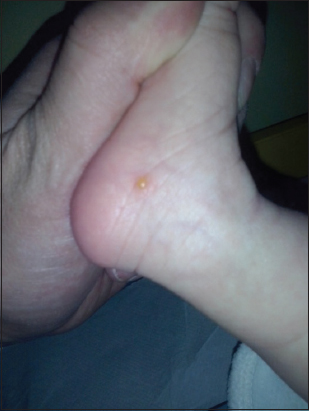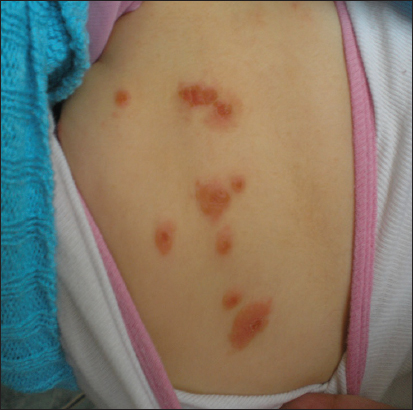Perinatal varicella
Anca Chiriac123, Piotr Brzezinski4, Adina Coroaba15, Meda Bradeanu6, Vlad Gorduza7
1Centre of Advanced Research in Bionanoconjugates and Biopolymers, “Petru Poni” Institute of Macromolecular Chemistry of Romanian Academy, 2Dermato-Physiology Department, Apollonia University Iasi, Iasi, Romania[3] Department of Dermatology, Nicolina Medical Center, Iasi, Romania[4] Department of Dermatology, 6th Military Support Unit, Ustka, Poland[5] The East European Network of Excellence for Research and Development in Chronic Diseases CHRONEX-RD, “Grigore T. Popa” University of Medicine and Pharmacy Iasi, Romania[6] Department of Neonatology, “Elena Doamna” Obstetrics Hospital, Iasi, Romania[7] “Grigore T. Popa” University of Medicine and Pharmacy Iasi, Romania
Sir,
Neonatal varicella infection has been rarely reported since vaccine introduction. Neonatal varicella occurs in the first 28 days of life and is due to infection developed by mother during last 5-7 days of delivery and 5- 7 days post delivery or in case of similar infection acquired by other siblings [1,2].
Neonatal varicela should be differentiated from “fetal varicella syndrome, congenital varicela with high morbidity and mortality.
Rapid and accurate diagnosis is of great importance on therapy and prognosis.
Two cases of neonatal varicela treated with systemic acyclovir are presented.
Case 1: A 28-day old female patient was seen in Dermatology Hospital for vesicular rash distributed on the limbs and trunk, few vesicles were scattered mostly on the superior part of the body (Fig. 1).
No systemic symptoms, usual lab analysis within normal limits for the age. Tzanck smear showed multinucleate giant cells, history of recent chicken pox in older brother was admitted by the mother, and serology confirmed the diagnosis of neonatal varicella.
Good response and complete recovery was achieved under systemic administration of acyclovir 20mg/kg iv 8 hourly for 10 days.
Case 2: A 17-day old male premature born baby was referred to Dermatology Unit for vesicular lesions spread on the limbs, trunk and scalp accompanied by high fever (Fig. 2). His mother was treated for varicella one week before admittance to the hospital, meaning approximately 10 days after delivery.
Based on clinical aspect of the lesions, close contact with mother infected with varicella 10 days postpartum, the presence of typical multinucleate giant cells on Tzanck smear a diagnosis of neonatal varicella was admitted and a treatment with acyclovir iv was started. Serology was negative. For the following 14 days the baby boy has received acyclovir 20 mg/kg 8 hourly with good response and no complications. A close follow-up was recommended.
DISCUSSION
If maternal infection occurs during 8–20 weeks of pregnancy fetus has a risk of developing varicella embryopathy known as “fetal varicella syndrome” characterized by ophtalmological, muscle and skeletal anomalies, mental retardation, microcephaly, urological defects [3,4].
Congenital varicella occurs if the mother got the infection at 13-20 weeks gestation and presents in new borns with skin scars, growth retardation, limb defects, chorioretinitis, neurological involvement [1]. The prognosis is poor, mortality high, around 30% [2].
When the maternal infection occurs after 20 weeks of gestation some reports highlighted an increased risk of herpes zoster during childhood [5].
Neonatal varicella occurs in the first 28 days of life and is due to infection developed by mother during last 5- 7 days of delivery and 5- 7 days post delivery or in case of similar infection acquired by other siblings [3,4].
Two types of neonatal varicela exist: if the mother has been infected less than 5 days before birth or 2 days after delivery, varicella-associated antibodies are not transmitted to the newborn and the infection is severe; if the mother has got the infection more than 5 days prior to birth, antibodies have been transmitted to the child causing a less severe form of the disease [2].
It is of outmost importance to consider the moment of varicela virus infection that will guide the therapeutical approach.
Maternal treatment includes oral acyclovir within 24 h of onset [6].
If maternal infection occurs 5-7 days before delivery or 2 days after giving birth a prophylactic approach to the child is mandatory using varicella zoster immunoglobulin or intravenous acyclovir, if immunoglobulin therapy is not available or the diagnosis was made 96 hours after exposure [6].
ACKNOWLEDGEMENTS
This work received financial support through the “Program of Excellence in multidisciplinary doctoral and postdoctoral research in chronic diseases”, contract no. POSDRU/159/1.5/S/133377, project co-financed by the European Social Fund Operational Programme “Human Resources Development” for 2007-2013.
REFERENCES
1. Enders G, Miller E, Cradock-Watson J, Bolley I, Ridehalgh M, Consequences of varicella and herpes zoster in pregnancy: prospective study of 1739 casesLancet 1994; 343: 1548-51.
2. Lécuyer A, Levy C, Gaudelus J, Floret D, Soubeyrand B, Caulin E, Pediatricians Working Group. Hospitalization of newborns and young infants for chickenpox in FranceEur J Pediatr 2010; 169: 1293-7.
3. Ghosh S, Neonatal pustular dermatosis: an overviewIndian J Dermatol 2015; 60: 211.
4. Sharma CM, Sharma D, A classical case of neonatal varicellaJ Clin Neonatol 2013; 2: 200.
5. De Araújo T, Schachner L, Benign vesicopustular eruptions in the neonateAn Bras Dermatol 2006; 4: 359-66.
6. American Academy of Pediatrics Varicella-Zoster Infections. Pickering LK, Baker CJ, Kimberlin DW, Long SS, Red Book: 2009 Report of the Committee on Infectious Diseases 2009; 28th Edition. Elk Grove Village, Illinois: American Academy of Pediatrics; 714-27.
Notes
Source of Support: Program of Excellence in multidisciplinary doctoral and postdoctoral research in chronic diseases and European Social Fund Operational Programme “Human Resources Development” for 2007-2013,
Conflict of Interest: None declared.


Comments are closed.